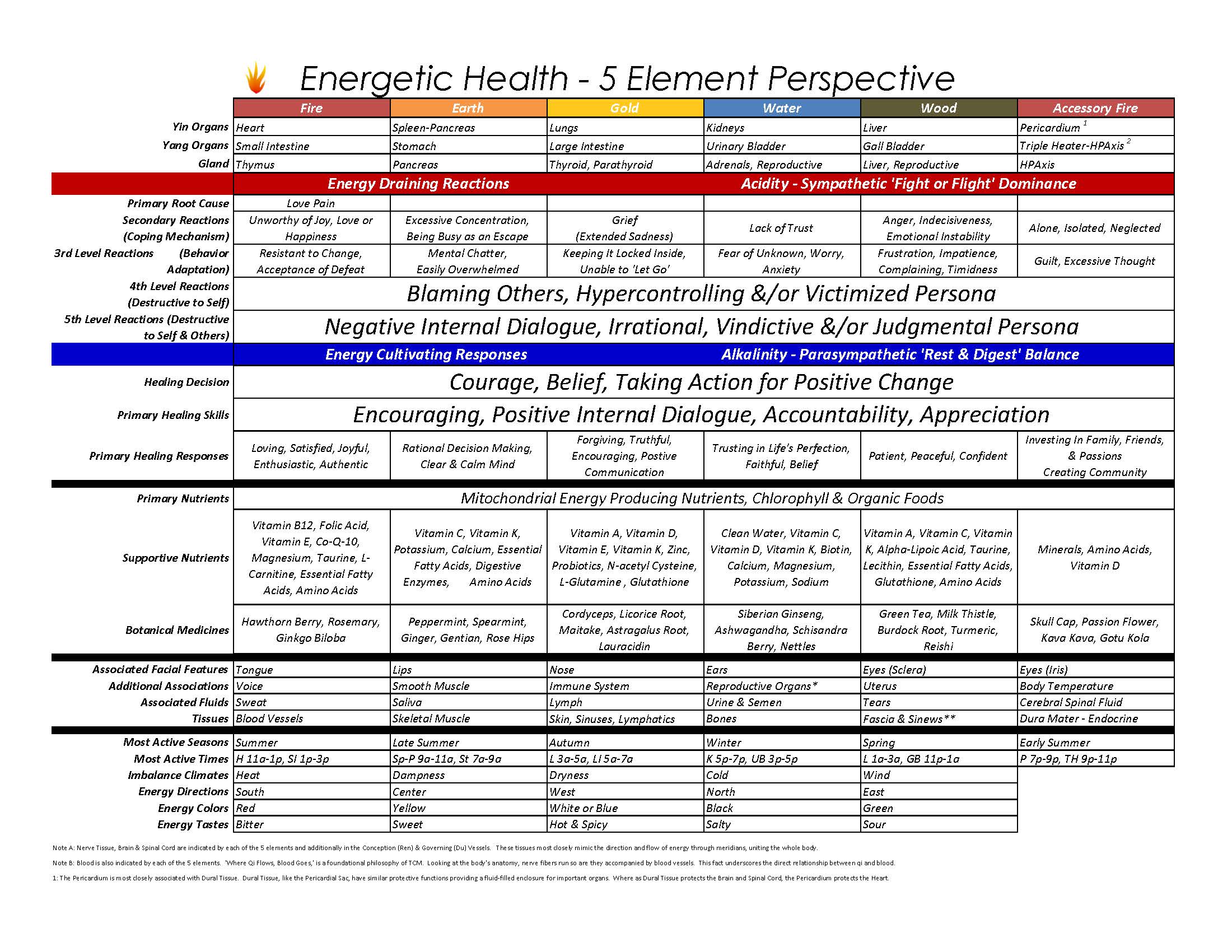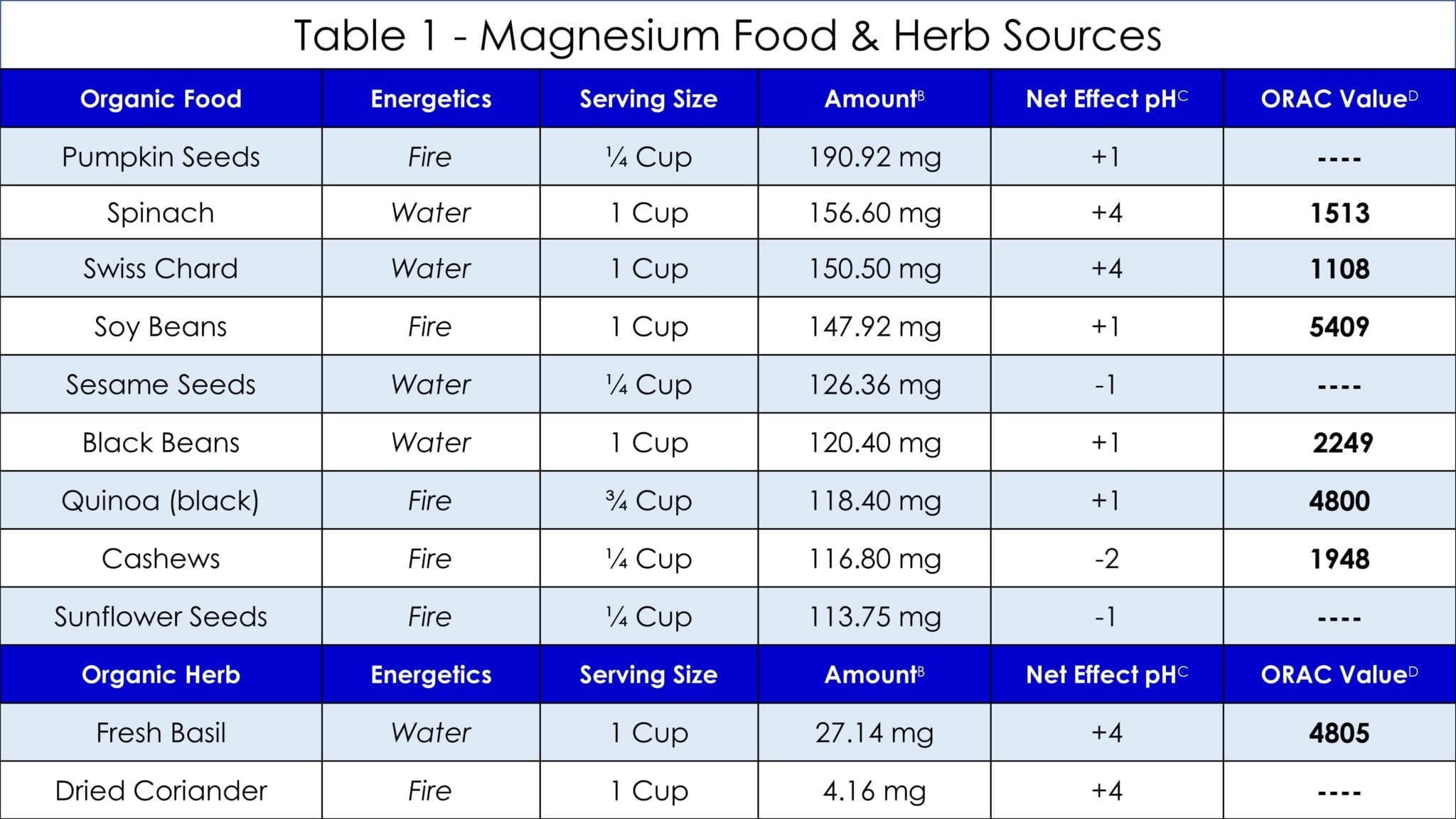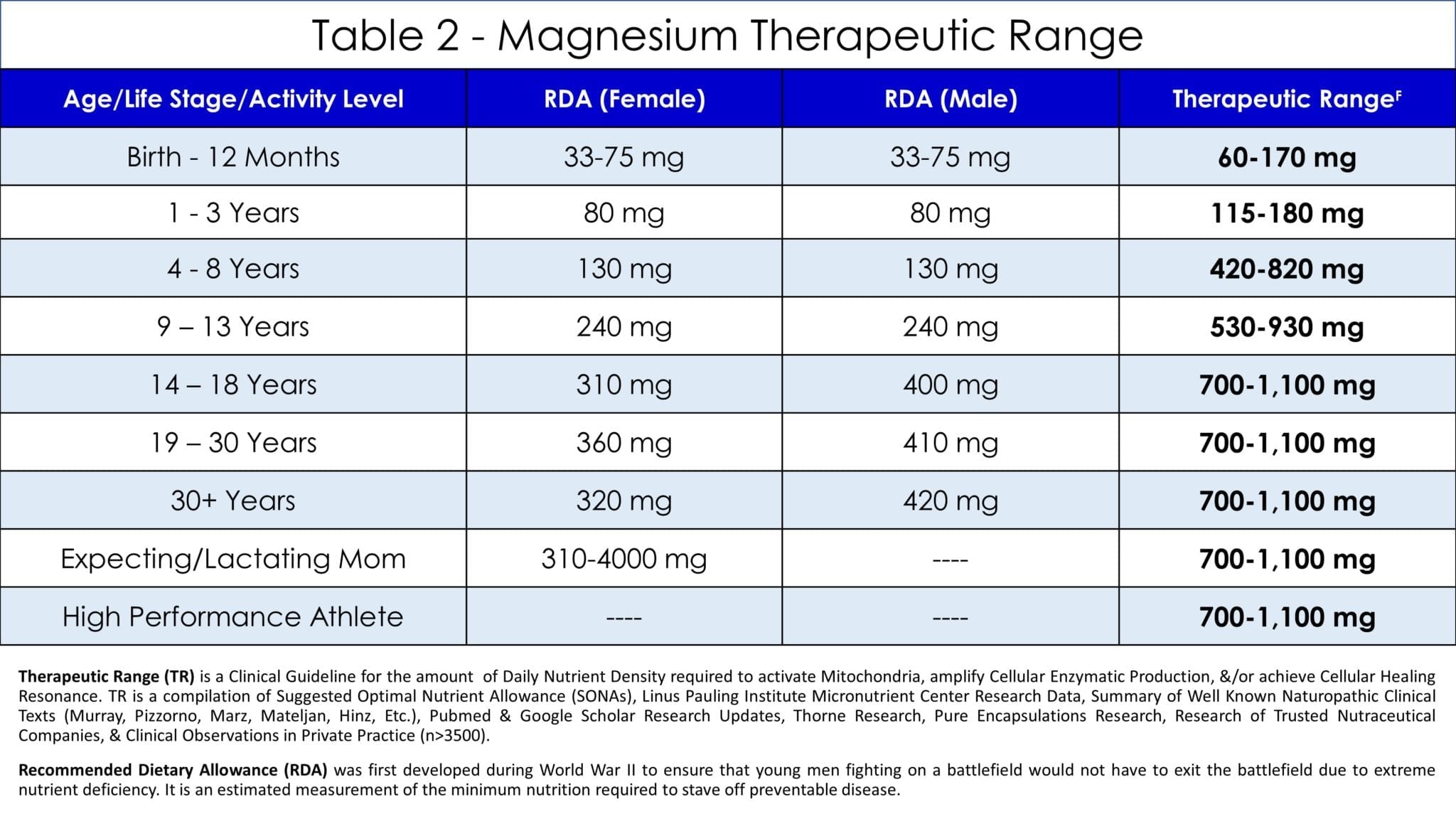Magnesium – EHI eLibrary

Author: Dena Wessler, CHN, CRC & Henele E’ale, ND, BCHN
Editor: Shannon Summers, CHN
Date: Oct 3, 2019
Energetic Health Overview
What makes Magnesium so amazing for you and your Energetic State, Emotional State, Anatomy, Physiology & Cellular Biochemistry? Having trouble going number 2? Blood pressure a little high? Are you seriously exhausted?
Magnesium is necessary for the activation of over 300 absolutely crucial enzymes and the pinnacle of its importance can be witnessed in the manufacture of the energy molecule of ATP (Adenosine Triphosphate). So, without Magnesium energy production wouldn’t be possible! It’s an essential nutrient, which means that your body can’t synthesize it and therefore must get it from foods, herbs and/or supplements. Magnesium is also a water-soluble nutrient, which means it must be replenished daily to maintain therapeutic levels in your blood stream and tissues.
Glutathione, also known as ‘the master antioxidant’, protects your body from the damaging effects of free radicals that inhibit your cells from doing their job. Interestingly, Magnesium is required for Glutathione synthesis and additionally, Magnesium helps to regulate Calcium, Sodium, and Potassium.
Magnesium is also the center molecule for Chlorophyll, which helps give green leaves their color. Chlorophyll is virtually identical in biochemical structure to a very important aspect of your body, the Heme subunits building blocks of each and every Hemoglobin molecule that makes up a single Red Blood Cells (RBC). Think about this for a moment. Each Hemoglobin molecule is comprised of 4 Heme subunits. Each RBC is comprised of approximately 300 million Hemoglobin molecules. And at any given moment the average person has over 30 Trillion RBCs in their blood stream. With your body making about 29 million new RBCs every minute of your day, it makes the daily consumption of Chlorophyll absolutely essential. And with that daily consumption of something green guess what else you get? That’s right a daily dose of Magnesium to help activate all your body’s enzymatic needs. Coffee or Chlorophyll, you decide which one is more important.B,1,2,4
Magnesium – When You Don’t Have Enough
Magnesium deficiency can be associated with Fatigue. People at higher risk of Magnesium deficiency include those with renal or gastrointestinal disorders, older people, and people suffering with chronic alcoholism. High blood sugar can also contribute to magnesium deficiency.
Here are some signs & symptoms of acute Magnesium deficiency:A,2,4
• Fatigue
• Insomnia
• Muscle Cramps
• Tremors
• Loss of Appetite
• Nausea
• Headaches
• Depression
And signs & symptoms of chronic Magnesium deficiency:A,2,4
• Chronic Fatigue Syndrome
• Osteoporosis (Bone Loss)
• Diabetes
• Depression/Anxiety
• Mood Instability
• Hypertension (High Blood Pressure)
Energetics
Because of Magnesium’s far reaching health effects, its Energetics falls into the Traditional Chinese Medicine (TCM) categories of the Fire Element (Heart, Small Intestine) and Water Element (Kidneys, Urinary Bladder, and Adrenal Glands).
Eating organic alkalizing foods, herbs, and supplements rich in Magnesium that support these Elements and their Organs & Glands is the key to achieving the multitude of benefits created by living an Energetic Health lifestyle.

Foods, herbs, thoughts & lifestyle practices that support your Fire Element will have positive effects on your Heart, Small Intestine, and Thymus. Foods & herbs with an Alkalizing net effect pH, including foods that are naturally bitter and red in color (flavonoids, lycopene and resveratrol) are often beneficial. Organic Alkalizing Foods will typically generate positive Energy Cultivating Moods that can help you overcome feeling unworthy of love and resistant to change and also calm your Nervous System leading to improved digestion and sleep. And lifestyle practices like Cardiovascular Exercise can give your Fire Element what it needs to perform at a high level for decades and decades.
Foods, herbs, thoughts & lifestyle practices that support your Water Element will have positive effects on your Kidneys, Urinary Bladder & Adrenals. Foods & herbs with an Alkalizing net effect pH, including foods that are naturally salty and blue/purple (black) in color (Anthocyanins) are often beneficial. Organic Alkalizing Foods will typically generate positive Energy Cultivating Moods that can help you overcome Anxiety while also calming your Nervous System leading to improved digestion and sleep. And lifestyle practices like drinking clean water & organic herbal teas can give your Water Element the hydration it needs to perform at a high level every day.

Emotion
The foods we eat become moods we feel. How is this possible? It’s just food after all, right? If we were to say, ‘you are what you eat’, would that seem far fetched? Of course not, the foods you eat literally become structure within your body. Fats (healthy or unhealthy) become integrated within the Phospholipid Bilayer of your cells. Proteins (healthy or unhealthy) become your bones, muscles, and organs. We literally are what we eat…but can the same be true for our emotional state? What you feel has a great deal to do with what you eat too. Neurotransmitters, the molecules of emotion, are biochemical compounds your body makes every moment of every day. And where does the source material for your neurotransmitters come from? That’s right…from the food you eat. What you eat becomes what you feel. Eat acidic foods tainted with pesticides, GMOs, chemical preservatives and other chemical pollutants and your moods will trend towards negative, Energy Draining Reactions because pollution disrupts homeostasis. Anger isn’t just anger, it’s a sign of nutritional imbalance typically the result of too many chemicals in the blood stream. Eat organic plant-based alkaline foods, free from the chemical pollutants that effectively short-circuit your Nervous System, and your moods will trend towards positive, Energy Cultivating Responses (See 5 Element Image Above). It’s not rocket science, food is medicine even for the mind, and clean foods lead to clean moods.
With respect to Magnesium, a food like Organic Pumpkin Seeds that stimulates your Fire Element can lead to Energy Cultivating Responses like feeling Loving, Satisfied, Joyful, Enthusiastic, and Authentic. A food like Organic Spinach that stimulates your Water Element can lead to Energy Cultivating Responses like Trusting in the Perfection of Life.E
(Refer to Table 1 above for more insights.)
Anatomy
Looking at health and the human body holistically, it’s imperative that you understand how everything is connected. You are a luminous being and your body is designed to heal. Your Energetics influence your Emotion. Your Emotion influences your Anatomy in what most people term body language. Your Anatomy influences how your body functions, aka your Physiology. Your Physiology influences your Cellular Biochemistry. And coming full circle, your Cellular Biochemistry influences your Energetics. At EHI, we call this series of amazing holistic connectivity The Cycle of Influencing Energy (CoIE). Literally nothing is independent of or isolated from anything else. It’s all you and what you do for one aspect of your CoIE, you do for all.
Magnesium plays an essential role in virtually all aspects of the physical body because of its involvement in over 300 enzymatic processes including the production of ATP and synthesis of one of the body’s most critical antioxidants, Glutathione.
Magnesium affects the Anatomy two ways: First, due to it being a calcium antagonist it promotes muscle contraction/relaxation. Second, Magnesium helps maintain bone integrity. Did you know that 50-60% of the body’s Magnesium is stored in the bone? When Magnesium gets too low Parathyroid hormone levels decrease, which then diminishes the absorption of Calcium from your diet via the Intestines. As is so often the case, when one aspect of the body is out of balance, there is a ripple-like domino effect across many other aspects of the body and that is certainly the case with Magnesium as well.
Physiology
Magnesium plays a huge role in many of the functions of the human body. Physiologically, Magnesium has several important functions and benefits: 2,8,9,10
Immune System & Inflammation
• Diets low in Magnesium are tied to increases in inflammation
• Low grade inflammation can be related to Heart Disease, Diabetes, and Obesity
• Restoring Magnesium to appropriate levels also normalize inflammation levels partially by suppressing Interleukin (IL-6)
• IL-6 is an pro-inflammatory trigger
Cardiovascular System
• Magnesium impacts the Cardiovascular System through its effect on the contractibility of the Myocardium
• It influences the movement of ions like Sodium, Potassium, and Calcium across the sarcolemma membrane
• It influences the electrical activity and conduction system of the Heart promoting smooth, rhythmic, efficient contractions
• Magnesium also helps to relax smooth muscle tone, helping to lower elevated blood pressure associated with stress
Endocrine System & Blood Sugar Management
• Low Magnesium diets have been correlated with elevated blood sugars go hand in hand
Digestive System
• Magnesium relaxes smooth muscles of the digestive tract as well promoting peristalsis & optimal digestion
• Normalizes bowel function and movement in cases of constipation
Biochemistry
Biochemistry focuses on the biochemical processes that continuously occur inside the body to the cellular level for energetic functioning. Biochemically Magnesium has varied roles from DNA Repair, ATP Production, and Protein Synthesis.1,2,8,9,10
DNA Repair
• Nucleotide Excision Repair (NER) requires 20 different proteins
• Magnesium acts as a co-factor in nearly every NER stage of DNA Repair
Neurotransmission
• Magnesium effects the brain cell receptor NMDA (N-Methyl-D-Aspartate)
• When Magnesium is deficient, Depression can increase due to problems with NMDA receptors
Enzymatic Metabolization
• Magnesium activates cellular enzymes to help biotransform proteins, carbs, lipids & nucleic acids for cellular use
• Essential Co-factor to produce ATP (Energy) within Mitochondria
• Magnesium also assists in the transportation of Electrolytes across cell membranes
Cellular Respiration & Enzymatic Detoxification
• Maintenance of the Mitochondrial Electron Transport Chain
• Essential for Glutathione synthesis for cellular detoxification
• A diet deficient in Magnesium can lead to mitochondrial dysfunction
Recommended Therapeutic Range


Get 10% Off On The Finest Medical Grade Supplements In The World!
Evidence-Based References
A. Energetic Health Holistic Nutrition Certification & Energetic Health v.1 by Dr. Henele, Genesis Publishing 2001 to 2019.
B. The World’s Healthiest Foods, George Mateljan. The George Mateljan Foundation 2001 to 2019.
C. Net Effect pH is a Teaching Concept Developed by Dr. Henele for Genesis Health Systems & the Energetic Health Institute. 2001 to 2019.
D. Oxygen Radical Absorbance Capacity (ORAC) Values provided courtesy of https://www.superfoodly.com/orac-values/
E. 5 Element Perspective is a Teaching Concept developed by Dr. Henele for Genesis Health Systems & the Energetic Health Institute. 2001 to 2019.
F. Therapeutic Range is a Teaching Concept developed by Dr. Henele for Genesis Health Systems & the Energetic Health Institute. 2001 to 2019.
1. The George Mateljan Foundation @2001-2019. August 16, 2019. http://www.whfoods.com/genpage.php?tname=nutrient&dbid=75
2. Assessed August 16, 2019. This link leads to a website provided by the Linus Pauling Institute at Oregon State University. The Energetic Health Institute is not affiliated or endorsed by the Linus Pauling Institute or Oregon State University. https://lpi.oregonstate.edu/mic/minerals/magnesium
3. PubMed.gov. US National Library of Medicine National Institutes of Health. “Magnesium Metabolism and its Disorders” R. Swaminathan 2003 May; 24(2): 47–66. PMID:18568054. Assessed: August 16, 2019. https://www.ncbi.nlm.nih.gov/pmc/articles/PMC1855626
4. Dr. Axe: Food Is Medicine. “Top 10 Magnesium Rich Foods” Rachael Link, MS. RD. December 31, 2018.
5. J. Elementol. 2010, 15(3): 601–616 Kazimierz Pasternak, Joanna Kocot, Anna Horecka Chair and Department of Medical Chemistry Medical University of Lublin. http://www.uwm.edu.pl/jold/poj1532010/jurnal-16.pdf
6. Dr. Axe: Food Is Medicine “9 Signs You Have Magnesium Deficiency and How to Treat it” Dr. Josh Axe, DC, DMN, CNS October 9, 2017. https://draxe.com/nutrition/vitamins/9-signs-magnesium-deficiency
7. PubMed.gov. US National Library of Medicine National Institutes of Health. “Muscle Cramps and Magnesium Deficiency: Case Reports.” D. L. Bilbey and V. M. Prabhakaran 1996 Jul; 42: 1348–1351. PMID: 8754704 Assessed: August 16, 2019. https://www.ncbi.nlm.nih.gov/pmc/articles/PMC2146789
8. PubMed.gov. US National Library of Medicine National Institutes of Health. “The human “magnesome”: detecting magnesium binding sites on human proteins.” Damiano Piovesan, Giuseppe Profiti, Pier Luigi Martelli, and Rita Casadio 2012; 13(Suppl 14): S10. Published online 2012 Sep 7. doi: 10.1186/1471-2105-13-S14-S10 PMID:23095498 Assessed: August 16, 2019. https://www.ncbi.nlm.nih.gov/pmc/articles/PMC3439678
9. PubMed.gov. US National Library of Medicine National Institutes of Health. “Magnesium Decreases Inflammatory Cytokine Production: A Novel Innate Immunomodulatory Mechanism.” Jun Sugimoto, Andrea M. Romani. Published online 2012 May 18. doi: 10.4049/jimmunol.1101765 https://www.ncbi.nlm.nih.gov/pmc/articles/PMC3884513/
10. PubMed.gov. US National Library of Medicine National Institutes of Health. “Phytochemical Contents and Antioxidant and Antiproliferative Activities of Selected Black and White Sesame Seeds” Lin Zhou, Xiaohui Lin. Published online 2016 Aug 14. doi: 10.1155/2016/8495630. https://www.ncbi.nlm.nih.gov/pmc/articles/PMC5002301/

Dena Wessler is a graduate of the Energetic Health Institute, Certified Holistic Nutritionist & Certified Raw Chef. She has worked in the natural healing arts and mental healthcare sectors for over 30 years. Having healed herself from the debilitating effects of Chronic IBS, Dena’s passion now focuses on helping people heal by rediscovering their unique worth and love of self. You can learn more about Dena at www.EatingForHealingHolisticNutrition.com.


